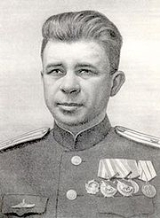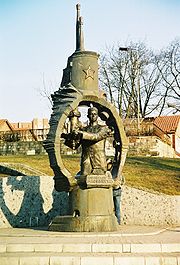
Alexander Marinesko
Encyclopedia

Soviet Union
The Soviet Union , officially the Union of Soviet Socialist Republics , was a constitutionally socialist state that existed in Eurasia between 1922 and 1991....
sailor and, during World War II
World War II
World War II, or the Second World War , was a global conflict lasting from 1939 to 1945, involving most of the world's nations—including all of the great powers—eventually forming two opposing military alliances: the Allies and the Axis...
, the captain of the S-13 submarine
Soviet submarine S-13
S-13 was a Stalinets-class submarine of the Soviet Navy. Her keel was laid down by Krasnoye Sormovo in Gorky on 19 October 1938. She was launched on 25 April 1939 and commissioned on 31 July 1941 in the Baltic Fleet, under the command of Captain Pavel Malantyenko.-Service history:In the first half...
, which sank the German
Nazi Germany
Nazi Germany , also known as the Third Reich , but officially called German Reich from 1933 to 1943 and Greater German Reich from 26 June 1943 onward, is the name commonly used to refer to the state of Germany from 1933 to 1945, when it was a totalitarian dictatorship ruled by...
ship Wilhelm Gustloff, with recent research showing that over 9,000 died when the ship sank.
Born in Odessa
Odessa
Odessa or Odesa is the administrative center of the Odessa Oblast located in southern Ukraine. The city is a major seaport located on the northwest shore of the Black Sea and the fourth largest city in Ukraine with a population of 1,029,000 .The predecessor of Odessa, a small Tatar settlement,...
, Marinesko was the son of a Romania
Romania
Romania is a country located at the crossroads of Central and Southeastern Europe, on the Lower Danube, within and outside the Carpathian arch, bordering on the Black Sea...
n sailor and a Ukrainian
Ukraine
Ukraine is a country in Eastern Europe. It has an area of 603,628 km², making it the second largest contiguous country on the European continent, after Russia...
woman. His father had fled to Russia after beating an officer and settled in Odessa, changing the last letter "u" of his name to "o". Alexander trained in the Soviet Merchant Navy and the Black Sea Fleet
Black Sea Fleet
The Black Sea Fleet is a large operational-strategic sub-unit of the Russian Navy, operating in the Black Sea and the Mediterranean Sea since the late 18th century. It is based in various harbors of the Black Sea and the Sea of Azov....
, and was later moved to a command position in the Baltic Fleet
Baltic Fleet
The Twice Red Banner Baltic Fleet - is the Russian Navy's presence in the Baltic Sea. In previous historical periods, it has been part of the navy of Imperial Russia and later the Soviet Union. The Fleet gained the 'Twice Red Banner' appellation during the Soviet period, indicating two awards of...
. In the summer of 1939 he was appointed commander of the new submarine M-96. When it entered service in mid-1940, it was declared to be the best submarine of the Baltic Fleet, and Marinesko was awarded a golden watch.
After the German invasion of the USSR in June 1941, the high command of the Baltic Fleet decided that the M-96 should be sent to the Caspian Sea to serve there as a training boat. But this could not be realized because of the German blockade of Leningrad. On 12 February 1942 a German artillery shell hit the M-96 causing considerable damage. The repair required more than four months. Because of the long inactivity, the level of battle training of the crew was low. Marinesko began to find consolation in alcohol, and he was expelled as candidate member of the Communist Party.
During a patrol near the Finnish coast, on August 14, 1942 Marinesko spotted the German heavy artillery barge (Schwerer Artillerie-Träger) SAT-4 "Helena". He launched a torpedo and later reported that he has observed the sinking of the barge. In 1946 the barge was turned over to the Soviet Baltic Fleet as war prize and it was found that her displacement was not 7,000 BRT as claimed by Marinesko, but only 400 BRT. Then Marinesko exposed his submarine to real risk by prematurely returning without any warning to his base. Soviet patrol boats attacked M-96, and a tragedy was avoided by sheer luck. In October 1942 M-96 had to disembark a commando detachment on the coast of the Narva
Narva
Narva is the third largest city in Estonia. It is located at the eastern extreme point of Estonia, by the Russian border, on the Narva River which drains Lake Peipus.-Early history:...
Bay. Its task was to attack a German staff and capture an "Enigma" coding machine
Enigma machine
An Enigma machine is any of a family of related electro-mechanical rotor cipher machines used for the encryption and decryption of secret messages. Enigma was invented by German engineer Arthur Scherbius at the end of World War I...
. However, only half of the group returned, without the machine. But because Marinesko had performed this task successfully, he was decorated with the Lenin order and he was promoted to "Kapitan treti rang" (Major). He was again admitted as candidate-member of the Communist Party.
In the beginning of 1943 Marinesko was appointed commander of the modernized submarine S-13. Of the 13 units of the type S (Stalinets), series IX and IXbis, only this boat survived the war. Leaving the base in the Finnish town of Hanko in October 1944, S-13 took position near the Hela peninsula
Hel Peninsula
Hel Peninsula |Nehrung]]) is a 35-km-long sand bar peninsula in northern Poland separating the Bay of Puck from the open Baltic Sea. It is located in Puck County of the Pomeranian Voivodeship.- Geography :...
, where the main German communication lines passed. Marinesko soon spotted the small transport ship "Siegfried" (563 BRT) and launched four torpedoes, that all failed. Then he surfaced and opened fire at the ship with his cannons. He reported 15 hits and that, as a result, the ship was sunk. He stated that the displacement of this ship was 6,000 BRT. In fact, the "Siegfried" was hit severely, but managed to reach the harbour of Danzig.
After spending the new Year's night 1945 in Hanko with a Swedish woman, owner of a restaurant, Marinesko disappeared for several days. It was proposed that he be court-martialed as a deserter, and this could be fatal for him. Moreover, fraternisation between Soviet citizens and foreigners was not allowed. But the commander of the Baltic Fleet Admiral V.F.Tributs realized that in such case the S-13 would not be operational for a long time. Therefore, Marinesko was sent on a new mission to prove his abilities.
Marinesko left Hanko on January 11, 1945 and took position near Kołobrzeg on January 13. In the next days his submarine was attacked several times by German torpedo-boats. Then on January 30 followed the "torpedo attack of the century", the sinking of the liner Wilhelm Gustloff.
It is now evident that the Wilhelm Gustloff was evacuating mostly civilians rather than military personnel. Of the nearly 10,000 people on board, most were civilians and refugees fleeing the advancing Russian on the Eastern Front - of these around half were woman and children. With 5,400 to 9,400 fatalities the sinking of the Wilhelm Gustloff was the single worst maritime disaster in history. While many call Marinesko's actions a war crime, he was never charged, and Soviet propaganda covered up the tragedy.
Only days later, on February 10, Alexander Marinesko sank a second German ship with two torpedoes, Steuben, this time carrying mostly wounded military personnel, with an estimated total number of 4,267 casualties. Marinesko has maneuvred submerged for four hours, following the enemy by sonar. He was convinced that the target was the light cruiser Emden
German cruiser Emden
The German light cruiser Emden was the only ship of its class. The third cruiser to bear the name Emden was the first new warship built in Germany after World War I....
. This way, Marinesko became the most successful Soviet submarine commander in terms of Brutto Register Tonnage (BRT) sunk with 42,000 BRT to his name.

Hero of the Soviet Union
The title Hero of the Soviet Union was the highest distinction in the Soviet Union, awarded personally or collectively for heroic feats in service to the Soviet state and society.-Overview:...
title: his commanders refused to trust reports regarding the scale of the hit; in addition, he was deemed a controversial person, "not suitable to be a hero". Instead, after the hits were confirmed, he was awarded the Order of the Red Banner
Order of the Red Banner
The Soviet government of Russia established the Order of the Red Banner , a military decoration, on September 16, 1918 during the Russian Civil War...
. Marinesko felt personally insulted, and when staff officers came to present him the order on his submarine, he gave the order to submerge her.
During his next mission from April 20 to May 13 Marinesko did not conduct a single attack, although he was sent to an area with intensive traffic of enemy ships. This mission was evaluated as unsatisfactory.
Due to problems with discipline and his alcoholism
Alcoholism
Alcoholism is a broad term for problems with alcohol, and is generally used to mean compulsive and uncontrolled consumption of alcoholic beverages, usually to the detriment of the drinker's health, personal relationships, and social standing...
, in September 1945 Marinesko was removed from submarine command and transferred to shore duty, with a lowered rank, and in November he was discharged from the Navy. In the following years Marinesko ruined himself. In 1949 he was sentenced to two years for theft in a Kolyma
Kolyma
The Kolyma region is located in the far north-eastern area of Russia in what is commonly known as Siberia but is actually part of the Russian Far East. It is bounded by the East Siberian Sea and the Arctic Ocean in the north and the Sea of Okhotsk to the south...
prison camp. He died in 1963 in Leningrad of an ulcer.
Marinesko was awarded the title Hero of the Soviet Union posthumously, in May 1990, on the occasion of the 45th anniversary of the victory in Europe. In St. Petersburg, the Stroitelei Street has been renamed in his honor around the same time: Ulitsa Marinesko, located in the Kirovskiy District,connecting the Avtovskaya and Zaitseva streets. The Submarine Museum in St. Petersburg was named after him, and monuments dedicated to him were erected in Kaliningrad, Kronstad and Odessa. He is one of the more prominent characters in the Günter Grass
Günter Grass
Günter Wilhelm Grass is a Nobel Prize-winning German author, poet, playwright, sculptor and artist.He was born in the Free City of Danzig...
' novel Crabwalk
Crabwalk
Crabwalk, published in Germany in 2002 as Im Krebsgang, is a novel by Danzig-born German author Günter Grass. As in earlier works, Grass concerns himself with the effects of the past on the present; he interweaves various strands and combines fact and fiction...
(2002), and describes in detail the sinking of the Wilhelm Gustloff.

